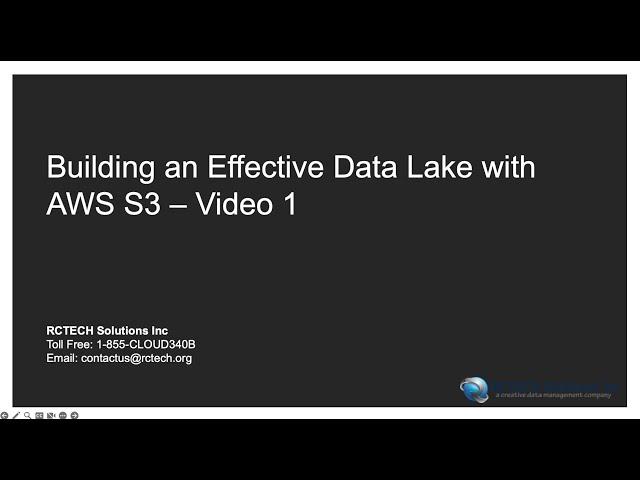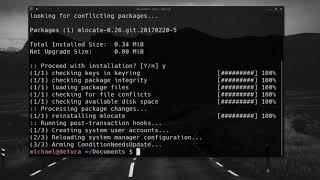
Part #1- Building an Effective Data Lake with AWS S3 ( Video 1)
Title: Building an Effective Data Lake with AWS S3
Slide 1: Introduction
Welcome and introduce the topic of building an effective data lake using AWS S3.
Mention the benefits of data lakes and the importance of using cloud-based solutions like AWS S3.
Slide 2: What is a Data Lake?
Define a data lake as a centralized repository that stores structured, semi-structured, and unstructured data at any scale.
Emphasize the ability to store raw and processed data in its original format for future analysis.
Slide 3: Benefits of Using AWS S3 for Data Lakes
Discuss the advantages of using AWS S3 for building a data lake:
Scalability: S3 allows for virtually unlimited storage and can handle large volumes of data.
Durability: S3 provides 99.999999999% durability, ensuring data is highly available and protected.
Cost-effectiveness: S3 offers cost optimization through pay-as-you-go pricing and tiered storage options.
Integration: S3 integrates seamlessly with other AWS services, enabling a comprehensive data ecosystem.
Slide 4: Architectural Overview
Present a high-level architectural overview of an effective data lake built using AWS S3.
Show the components involved, such as data sources, data ingestion, storage in S3, data processing, and data consumption.
Slide 5: Data Ingestion
Explain the process of data ingestion, which involves bringing data into the data lake.
Highlight various methods available in AWS for data ingestion:
Direct uploads to S3 using AWS Management Console or SDKs.
Streaming data using services like Amazon Kinesis Data Firehose.
Batch data transfers using AWS Snowball or AWS Glue.
#aws #datalake #dataanalytics #dataintegration
Slide 1: Introduction
Welcome and introduce the topic of building an effective data lake using AWS S3.
Mention the benefits of data lakes and the importance of using cloud-based solutions like AWS S3.
Slide 2: What is a Data Lake?
Define a data lake as a centralized repository that stores structured, semi-structured, and unstructured data at any scale.
Emphasize the ability to store raw and processed data in its original format for future analysis.
Slide 3: Benefits of Using AWS S3 for Data Lakes
Discuss the advantages of using AWS S3 for building a data lake:
Scalability: S3 allows for virtually unlimited storage and can handle large volumes of data.
Durability: S3 provides 99.999999999% durability, ensuring data is highly available and protected.
Cost-effectiveness: S3 offers cost optimization through pay-as-you-go pricing and tiered storage options.
Integration: S3 integrates seamlessly with other AWS services, enabling a comprehensive data ecosystem.
Slide 4: Architectural Overview
Present a high-level architectural overview of an effective data lake built using AWS S3.
Show the components involved, such as data sources, data ingestion, storage in S3, data processing, and data consumption.
Slide 5: Data Ingestion
Explain the process of data ingestion, which involves bringing data into the data lake.
Highlight various methods available in AWS for data ingestion:
Direct uploads to S3 using AWS Management Console or SDKs.
Streaming data using services like Amazon Kinesis Data Firehose.
Batch data transfers using AWS Snowball or AWS Glue.
#aws #datalake #dataanalytics #dataintegration
Тэги:
#Building_an_Effective_Data_Lake_with_AWS_S3 #AWS #RCTECH_IT_Consulting #AWS_S3 #Data_Lakes_using_S3 #Datalakes #How_to_build_S3_Data_Lakes #What_is_a_Data_Lake? #Benefits_of_Using_AWS_S3_for_Data_Lakes #Data_IngestionКомментарии:
Part #1- Building an Effective Data Lake with AWS S3 ( Video 1)
RCTECH - Cloud Data Management
How to add bullets and list numbering in PowerPoint
Best Video Tutorials and Help from HowTech
Checkpoint Firewall | Day 1: Checkpoint R81 Next-Generation Firewall Training | CCSA+CCSE
I-MEDITA (IT Training Academy)
I. RETAIL TALK #13: Kund:innen wollen kuratierte Sortimente & Service online & offline – K. Stäbler
Günther Rid Stiftung für den bayerischen Einzelhandel






![Ed Sheeran - Shape Of You (Jesse Bloch bootleg) [FREE DOWNLOAD] Ed Sheeran - Shape Of You (Jesse Bloch bootleg) [FREE DOWNLOAD]](https://invideo.cc/img/upload/b0hOcmNDOFV2Tmg.jpg)



















